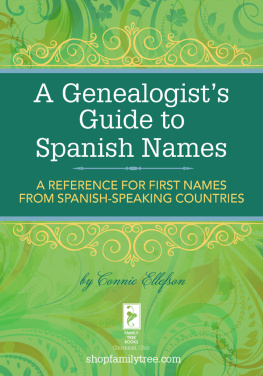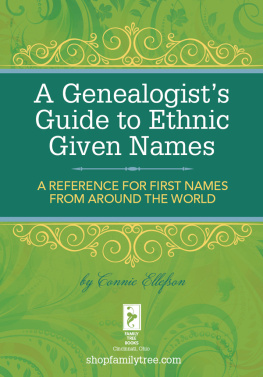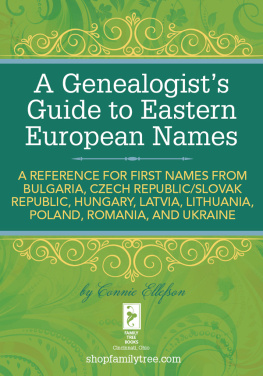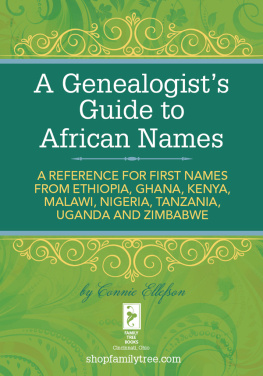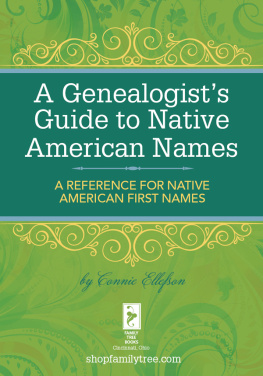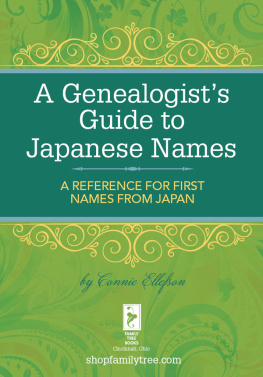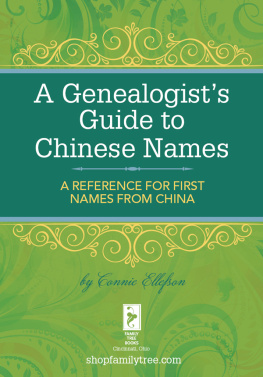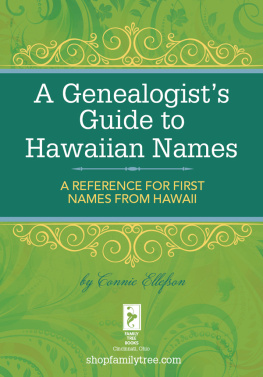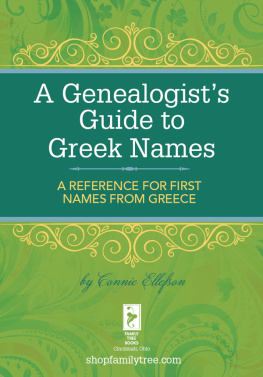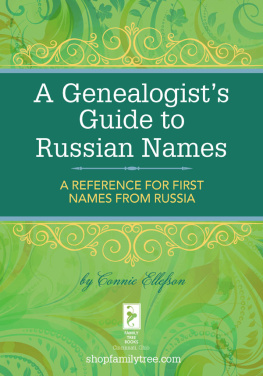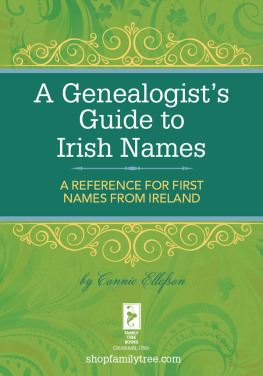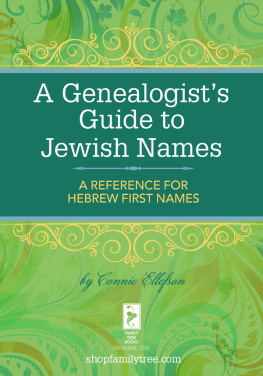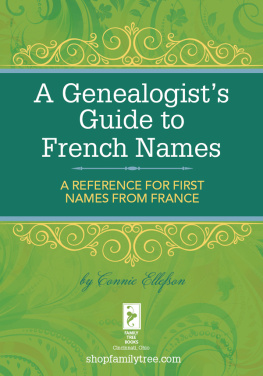A Genealogists Guide to Spanish NamesA REFERENCE FOR FIRST NAMES FROM SPANISH-SPEAKING COUNTRIESby Connie Ellefson Cincinnati, Ohio shopfamilytree.com
Spanish-Speaking Cultures
History
Since 1820, only 300,000 people have immigrated to the U.S. directly from Spain, although hundreds of thousands of Spanish-speaking people have immigrated from Puerto Rico, Mexico and Cuba. During the period of 1900 to 1920, millions of Spaniards emigrated; however, many more of them went to South and Central America, primarily Cuba and Argentina, where language would not be a barrier. Of the 174,000 who immigrated to the U.S. between 1900 and 1924, 70,000 returned to Spain. In northern Spain, the system of dividing plots of inherited land among relatives led to smaller plots, until some families didnt have enough land to cultivate profitably.
Most Spanish immigrants came from the Galicia province and the Basque region of northern Spain (see Basque chapter in Europe Section). Many settled around New York City. Spaniards from Andalusia in southern Spain were recruited to work on sugarcane plantations in Hawaii between 1903 and 1907. By 1920, most had moved to California. Cigar makers from the northern Spanish province of Asturias settled in Key West and Tampa after immigrating to Cuba. Other Spaniards took manufacturing jobs in the Midwest and coal mining jobs in Virginia.
During the 1880s, many Mexicans worked for the Southern Pacific and Sante Fe Railroads, constructing them or running them. Small communities that often sprung up along the rail lines to house permanent workers were the basis of many of todays Mexican American communities. However, the large-scale influx of Mexican laborers into the Southwest did not begin until the period between 1910 and 1925. Before that time, labor needs had been filled by slaves (until slavery was abolished in 1865)or by Chinese and Japanese (whose immigration was restricted by agreements in 1882 and 1902). During 1910 to 1925, a bloody civil war in Mexico killed over one million people. Homes and farms were destroyed, and many Mexicans fled north to escape the horror and poverty.
California, Texas, New Mexico and Arizona employed vast numbers of Mexican workers to raise cotton, fruits and vegetables. Mines in New Mexico, Colorado and Arizona employed many Mexican immigrants. The 1924 immigration laws did not place quotas on immigrants from Mexico or any other country in the Western Hemisphere, in the interests of diplomatic deference to Americas neighbors. However, during the economic hardship years of the 1930s, some 89,000 Mexican aliens were repatriatedvoluntarily or notto Mexico, because the natural disasters of those years had caused a shortage of agricultural jobs, and many displaced Anglos from the Dust Bowl states now competed for the low-paying jobs that had been previously held by Mexicans. Altogether, nearly 2.4 million legal immigrants have entered the U.S. since 1820 from Mexico.
Some immigration from Puerto Rico occurred after 1900, but large numbers did not begin immigrating until the 1920s, when jobs were plentiful in the U.S. After World War I, a severe depression in Puerto Rico along with a rising birthrate and a falling death rate brought crowding and unemployment. Many Puerto Ricans immigrated to New York as well as Miami, New Orleans, Chicago and Boston. Puerto Ricans enjoyed U.S. citizenship after 1917 and could move to the mainland without any restriction. Since immigration laws of 1924 sharply reduced the numbers of European immigrants, Puerto Ricans had no trouble finding jobs, both skilled and unskilled, in New York and elsewhere.
During the Depression, immigration slowed considerably since jobs were as scarce in the U.S. as in Puerto Rico and the cost of boat fare was more than most Puerto Ricans earned in a year. During World War II, immigration all but halted, though there were jobs available, because submarine warfare in the Caribbean made the crossing very hazardous. Immigration rose after World War II, reaching a peak of 69,000 in 1953. A total of some 570,000 Puerto Ricans (net migration) moved to the mainland between 1945 and 1956. The vast majority lived in New York City.
After that, immigration slowed as automation took over many jobs they had previously filled and economic conditions improved in Puerto Rico.
Naming Traditions
Because the Roman Catholic faith is so important in Spain, and especially the adoration of the Virgin Mary, most girls are given the name Maria as part of their names or have some name that signifies a religious event, such as Concepcion or Milagros (miracles). They may have a name that is the short form of a reference to the Virgin Mary, such as the name Luz, which stands for Maria de la Luz (Mary of the Light). A boy may be named Salvator (savior) or Jesus (pronounced heh-SOOS), but names from other sources are popular, too. Nicknames and pet forms, especially of the male and female versions of Joseph and Francis, are common in Spain. Some names would be found only in particular regions of Spain (denoted N, S, E, W or combinations thereof).
In Puerto Rico, names for girls tend to be very trendy. Many girls a few years ago were named Diana, after Princess Diana of England. Before that, the name Marisol (Mary and sun) was popular when a young Puerto Rican woman of that name won the Miss Universe contest. Right now, the most popular girls names are heavily European influenced and include names like Vanessa, Lisette, Cecilia, Christine, Nicole and Melissa. Boys in Puerto Rico are usually named after their fathers, with Jose and Javier being the most popular names.
Pronunciation
a = ah as in ball e = eh as in late i= ee as in keep o = oh as in hope u = oo as in moon, u is silent in the syllables que, qui, gue and gui j = h as in hope b = a sound halfway between b and v c = th before e or i, k otherwise see d = a sound halfway between d and th as in there g = h as in hope before e or i, g as in go, in other cases ll = y as in yarn Vowels are always pronounced the same, whether accented or not.
Pronunciation
a = ah as in ball e = eh as in late i= ee as in keep o = oh as in hope u = oo as in moon, u is silent in the syllables que, qui, gue and gui j = h as in hope b = a sound halfway between b and v c = th before e or i, k otherwise see d = a sound halfway between d and th as in there g = h as in hope before e or i, g as in go, in other cases ll = y as in yarn Vowels are always pronounced the same, whether accented or not.
Accent marks have to do with which syllable is stressed.
Spanish Female Names
Adelina (NW) (OGer) noble, kind; Adela, Adelita
Adoracin adoration
Adriana (L) of the Adriatic
Africa (Gael) pleasant
Agata (Gr) good, kind; Agace, Agacia, Aggie, Agueda
Agnese (ahg-NEH-seh) (Gr) gentle, pure
Agueda (ah-GWAY-duh) (Gr) good
Aida help (rare)
Albertina (OGer) noble, bright; Elberta, Berta, Elbertina
Aldonza sweet Alegria (ah-leh-GREE-ah) happiness; Allegria
Alejandrina (ah-leh-hahn-DREE-nah) (Gr) defender of mankind; Drina
Alicia (Gr) truthful
Alita (OGer) noble; Adelina, Adelita, Dela, Lela

